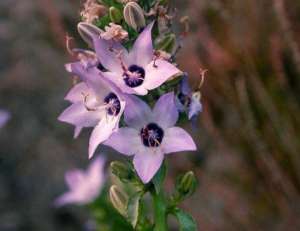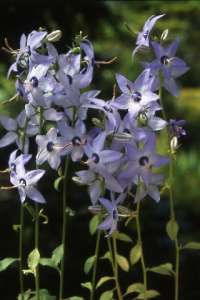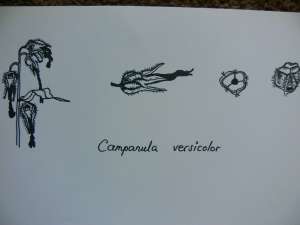Inhoud
versicolor
Campanula versicolor
Sibth. & Sm. (1806)
Leichtlin.Section VI: Elatines Wohlf. (1895)1) Synonym: Campanula corymbosa Ten. (1811), synonym: Campanula Tenorii Moretti (1824)2) Synonym Campanula x pyraversi Hort., Cayeux & Le Clerc.; Campanula pyramidalis x Campanula versicolor
Habitus
Erect perennial, to about 3 ft.
Perenni. Fusto prostrato-ascendente (2-4dm.), foglioso sino alla base dell'infiorescenza. 3) Graham Nicholls - Note: This species is reported as growing quite tall in the wild but my plants are a maximum of 12“ tall. It is striking with a deep blue eye.Leaves
Basal leaves oblong to ovate, nearly cordate at base, deeply serrate, petioles longer than blades, stem leaves narrower, sometimes nearly entire, the uppermost nearly sessile.
Fg. a denti mai glandolosi. Inflorescenza breve, racemoso-subcorimbosa. 4)
Flowers

Flower measuring, between 25 - 40mm (1 - 1 1/2 inch.)5)
Flowers more or less erect, in spicate racemes, calyx without appendages, lobes often serrulate, corolla pale blue then lighter above the deep violet throat, 1 in. across or more, rotate. Giu.-Lugl. Corolla manifestam. campanulata, divisa al piu sino a meta. Corolla azzurra cou 5 macchie violaceo-scure verso la base, rr. bianca, assai aperta ed a lobi ovali-bislunghi. Il resto c. s. 6)
Fruit
Varieties
* Campanula versicolor var. tenorei
* Campanula versicolor var. thessala
* Campanula versicolor var. tomentella
Origin
Mediterranean sea, central Italy to Greece.
Rupi calcari: Basil. a Mutera, Tarantino a Ginosa, Leucaspide e Grottaglie e Leccese a Gallipoli, tra Gallipoli ed Otranto ed al Capo di Leuca; 2. (Grecia).8) Graham Nicholls - Note: From the Balkan Peninsula and southeastern Italy this species is reported as growing quite tall in the wild. but my plants are a maximum of 12“ tall. It is striking with a deep blue eye.Beneficial
A nearly allied species or a variety of pyramidalis. The plant produces masses of pale blue flowers with a darker zone surrounding a whitish centre; the habit is not pyramidal but bushy, three feet high, and I can only liken it when in flower to a gigantic Gilia tricolor.They can be propagated from root cuttings and also by seed. Another method of propagation is to decapitate the crown in the autumn, when in the following spring many shoots will be found coming up, which can be easily separated.9)
Le Campanula sono entrate nei giardini fino dalla seconda meta del xvi secolo, secondo le testmonianze di Gerard e di Clarici. Tra il 1596 e il 1597 Gerard raccolse in Inghilterra esemplari di Campanula persicaefolia, Campanula pyramidalis e Campanula medium che nella flora spontanea inglese non esistono: il che significa, dando tempo al tempo, che probabilmente in Italia erano state trasportate, dallaliberta dei campi al chiuso degli orti, forse parecchi decenni prima. Con certezza sappiamo che nei giardini francesi furonointrodotte nel 1774 la Campanula carpatica, nel 1779 la Campanula alpina e la Campanula pulla, nel 1783 la Campanula sibirica, nel 1788 la Campanula versicolor e la Campanula mollis; in Inghilterra nel 1774 la Campanula carpatica, nel 1775 la Campanula thyrsoides e nel 1779 la Campanula pulla.10)



